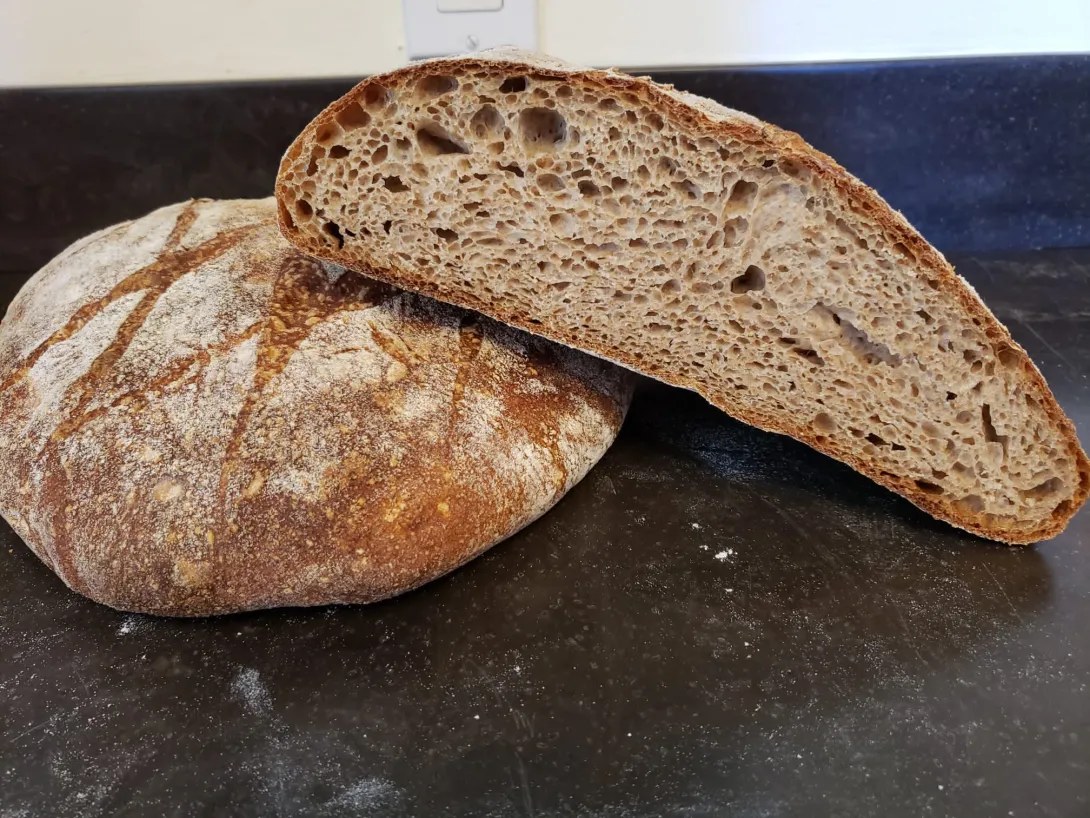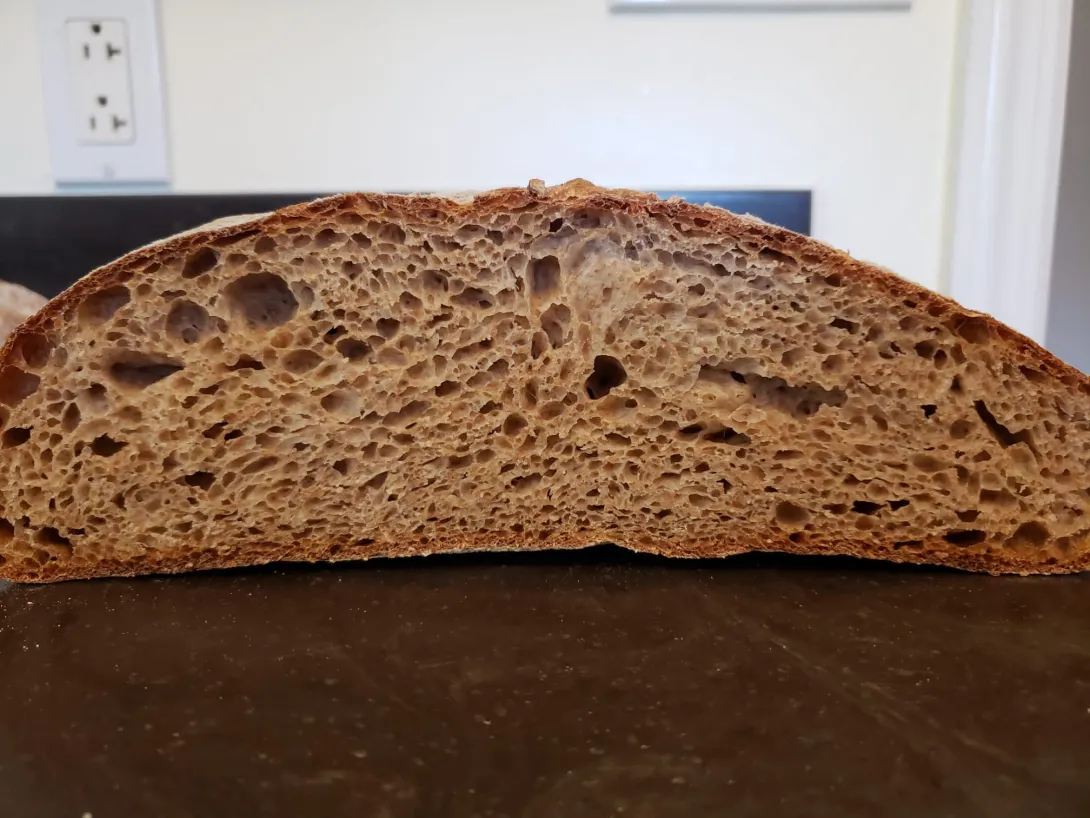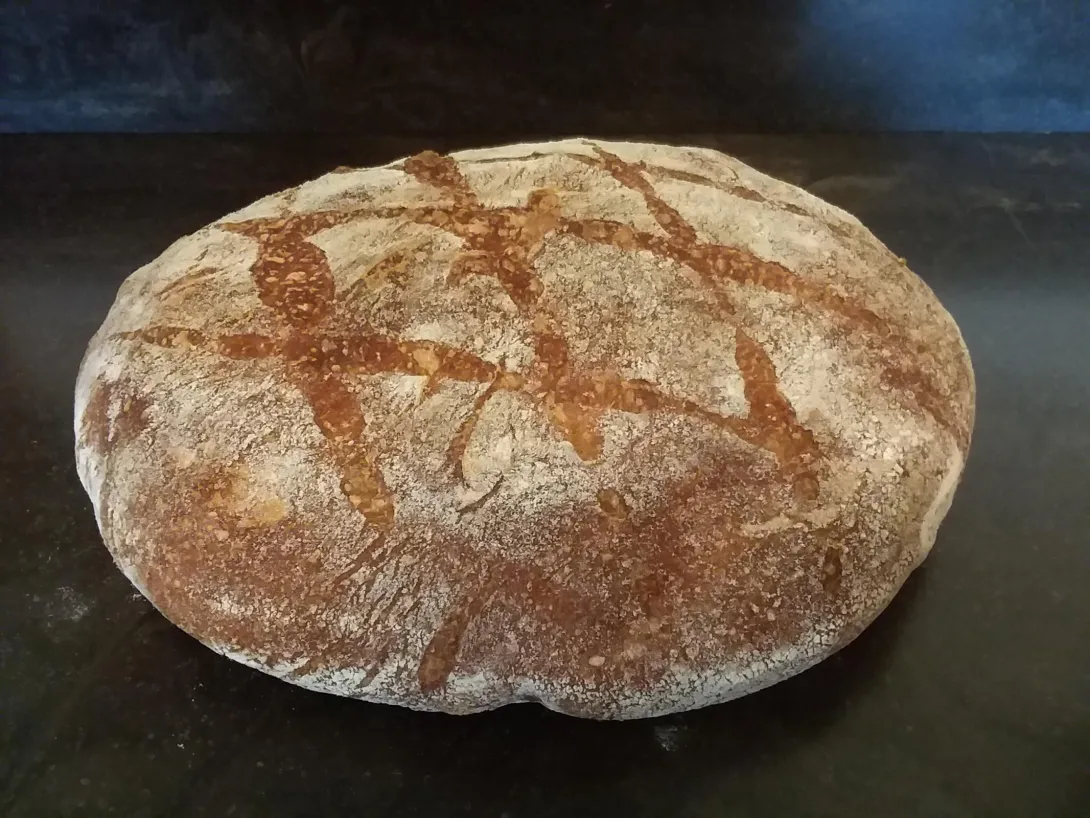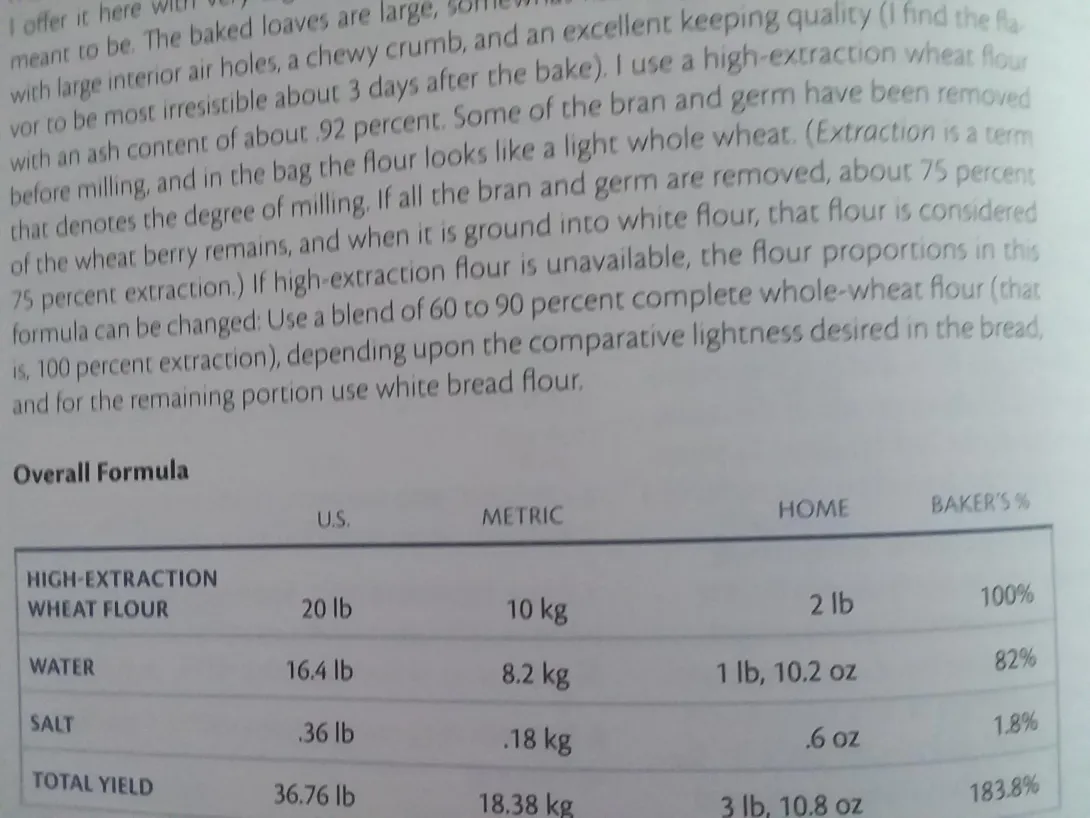
I have decided to try Mr. Hamelman's miche formula from his book Bread. I followed the formula and recommended procedure to the letter. I had to scale down the quantities to the total flour of 700 grams, so I would get a loaf of a little over one kilo, which is enough for me and my wife for about a week. Not having access to high extraction flour, I followed Mr. Hamelman's recommendation, and substituted it with a 60/40 mix of whole wheat flour and bread flour.
This is truly an excellent bread with great deep flavor and a soft and moist crumb. I was quite satisfied with the bake, except for two things. My scoring didn't open up much, and when slicing the baked loaf, the crumb felt a little bit sticky, even little pieces stuck to the knife. I let the dough cool after the bake for 18 hours before slicing it, so it was definitely cool enough.
Regarding the latter problem, the bread was definitely not underbaked, as I baked the loaf for an entire hour at 440 F for the first 15 minutes, then at 420 for 45 minutes. These are the exact times and temperatures in the formula for a loaf twice as large as mine. So, it must have baked fully. The color of the crust also suggests that it was well baked. I am wondering whether or not this particular bread is supposed to have a crumb that's a bit sticky, given the high hydration. I would love to hear from members who have experience with this bread. Otherwise, I suspect slightly overproofing, which would also explain the scoring problem. I followed the exact timeline for the bulk and the final proof, and my kitchen temperature was spot on at 75 degrees, so I am not sure how I could be overproofing. I highly doubt that I have a more active starter than the starter they use at the King Arthur Bakery, for which the formula was created! In any case, I would appreciate any insights! 

- tothpianopeter's Blog
- Log in or register to post comments
your specific ingredients (mainly flour, but also water) and local conditions.
Your bread looks great. Much better than most of my attempts.
--
Firstly, blending WW and white flour is an approximation of high-extraction flour, not a truely equivalent substitute.
High extraction flour is milled in a way that removes the outer bran, and most of the germ, leaving the white endosperm and inner bran layers.
By blending WW and white flour, you're getting more outer bran and germ, and less inner-bran, proportionaliy. So it just can't be the same flour. It can still make great bread, but don't expect it to perform exactly the same in terms of hydration needs, and fermentation speed.
second, no two whole wheat flours are the same. Not just different sub-species and strains, but different farms, fields, soil nutrients, moisture levels, milling methods, and storage/transport conditions. Flour can gain or shed moisture all along the way from the mill to your pantry and up to the time you use it.
(I store flour in the fridge. As soon as I open the bag, the humidity in the air starts to condense on the flour, and the flour absorbs it.)
Bottom line:
1) hydration almost always has to be adjusted. You can normally expect to make 3 bakes of a new-to-you formula to "dial it in." Two if you're smart, and experienced, and lucky. It usually takes me 5 to 16 tries. Storage method and local humidity also dictate adjustments.
2) most all those factors, species/sub-species/variety/strain of wheat, bran, germ, soil nutrients, milling method, age, also affect fermentation rates. So amount of levain, times, and temperatures need tweaked too.
--
To relate it to your profession..... " flour is not flour is not flour", perhaps like "a piano is not a piano is not a piano."
--
Added: I have the 1st edition of Bread. The sidebar on page 165 says 85% to 90% WW in the blend for this formula. Has this been changed for the 2nd or 3rd edition?
--
Added: In the first edition, Hamelman discusses hydration adjustments in the sidebar of page 38, at the end of page 91 continuing on to page 92, top of page 99, and 3rd paragraph of page 149.
For other editions, see the Index listings for "Hyrdration" and "Water - flour absorption."
for your comment! You are absolutely right. Formulas need to be adjusted. I think the hydration of 82% was fine for my flour, as it felt soft like Hamelman describes, but not overly wet like a ciabatta. Do you think that because I used WW flour and AP flour mix, the fermentation was faster than if I had used high extraction flour? I am still suspecting overfermentation, that's the only way I can explain the slightly moist and sticky crumb (which by the way lost some of the stickiness two days after the bake!).
I own the 2nd edition of the book, here is a snapshot of page 164 where the formula is. He recommends between 60% and 90% WW flour.
Image

"I am still suspecting overfermentation, that's the only way I can explain the slightly moist and sticky crumb (which by the way lost some of the stickiness two days after the bake!). "
You're jumping to a premature conclusion. That may be true. But... Moist and sticky can also be a feature of the type/strain of whole wheat. You're relatively new to whole wheat, correct? Some strains of wheat just make stickier flours than others.
Moist and sticky are also a function of hydration. WW absorbs water differently than white flour. This formula has a relatively short autolyse and bulk ferment for a >50% WW dough. I think water is finally getting fully absorbed toward the end of bulk ferment period.
So when you initially mix, the WW dough may feel right, but give it time, and it changes. It takes more time for bran to absorb water. It takes more time for a large particle to fully hydrate than a small particle. Hence the dough goes through phases. And this also goes back to how much pre-existing moisture is in the flour at the time you actually use it. That one bag of flour gains or sheds moisture sitting in your pantry or fridge.
Moist and sticky are also a feature of what kind of whole wheat. You haven't said what brand and type of whole wheat you used. Some people think spelt is wheat, and use spelt, but then come here and carelessly call it "wheat" until they are asked for the details. Spelt is notoriously sticky. Heirloom and ancient varieties of wheat can also be stickier than generic modern hard red or hard white wheat.
--
"Do you think that because I used WW flour and AP flour mix, the fermentation was faster than if I had used high extraction flour?"
If it is over-fermented, and I'm not yet convinced it is, that is only one of the possible reasons. Again, things like type of wheat, and whether it was freshiy milled are also big factors in the rate of fermentation. Recently milled WW ferments much faster than WW flour that has sat for months in a warehouse or store shelf or in your pantry.
--
There is also the matter of developing gluten. Developed gluten holds water better too. Your WW flour may inherently need more "work" than the formula calls for in order to develop a good gluten matrix.
--
Your crumb is very good compared to the photo in the book. Perhaps you're being too hard on yourself. But it is most bakers' nature to tweak things until it is juuuust the way we want it.
So if you want to dial back hydration and fermentation a tiny bit next time, that could get you where you want to go.
Dialing back fermentation could be done by less levain, or lower temp, or less time.
Yes, I am relatively new to WW. I have used WW in breads up to about 20%, but I don't have a lot of experience in using 60% or more, like in this bread. I haven't thought of the stickiness coming from the WW flour itself, but that might be the case. For this bread I used a plain store brand WW flour, it has 12.7% protein, for the rest I used KA AP flour.
I think next time I will try to cut back on the final proof time a little bit and see what happens. People also say that a weak starter can also cause a sticky crumb, but that's not the case. I have a stiff starter that I keep in the fridge between bakes, and it's definitely not weak. After final mixing, I removed a small sample of the dough and put it in an aliquot jar to monitor fermentation. At the end of the 2 and a half hours of bulk fermentation, the sample practically doubled in size. I think it's quite fast for sourdough, perhaps even too fast for the timeline given in the formula? Maybe I should cut back on the bulk fermentation time? Of course the main dough didn't quite double by the end of the bulk phase because there is always some degassing during the folds. I think it grew maybe 50% or so.
Dave, much the same obtains with bolted four, right? I get 88% with my two sieves of Turkey Red, and this bread is waiting in the wings. I seem to recall Central Milling offers a high-extraction flour but unfortunately they're on hold for awhile.
Home sifting whole wheat flour is a different process than how big commercial roller mills make high extraction flour.
See my comment above about mixing WW and and white flour.
By sifting at home, you're going to get a different combination of outer-bran, inner-bran, and germ..... compared to how they do it at a big roller mill.
Roller mills work on the kernal from the outside in. They can separate outer-bran, inner-bran, germ, outer-endorsperm, and inner-endosperm.
Your sifter, when working on WW flour can't control any of that. The sifter only knows particle size, and "keeps" the big particles. Those big particles that don't pass through can be _any of the above_: outer-bran, inner-bran, outer-endosperm, inner-endosperm, etc.
It will be an approximation.... somewhat similar, but not the same.
(Flour is not flour is not flour. Just like a pro or any serious piano player knows "a piano is not a piano is not a piano.")
--
So don't expect identical performance. But if you adapt the things you can control, you still get a very good loaf of bread.
OK, I thought so. The #30 and #50 doesn't care what they're holding back. It is actually interesting to me because it seems like bolted flour is a "thing." The company I got the Turkey Red from offers it bolted as well. Given that this is not high-extraction flour, what is the benefit of a bolted flour? Just a finer flour, with smaller bran and other particles that can shear gluten networks (like using Central Milling's Hi-Pro Fine WW)?
I'm actually really excited to make this miche with the Turkey Red, bolted and entire, both. I remember Danny comparing heirloom flours - it's what got me geeked on the TR and we're so lucky to have local growers who do it (as well as Red Fife and some others).
"Given that this is not high-extraction flour, what is the benefit of a bolted flour? "
To get some bran out. Few people like 100% WW.
Look at the bakes/formulas posted on TFL. Very few are 100% WW. My guess is at least 95% of the posts don't go over 80% WW.
Of the posts that do include any WW, most are 50% or less WW.
Once you get over 85% WW, it's very hard (not impossible) to get that sexy oven spring. It takes a lot of practice to get there, and a lot of time and effort working the dough. You can do a "no-knead" process on 100% WW, and it will still be tasty, but it won't get you the same oven spring as when you work/knead/mix the dough.
--
If you meant "Why bolted(sifted) flour versus high-extraction?" The answers could be:
a) the miller has a stone mill as opposed to a roller mill.
b) the miller has a smaller less-sophisticated roller mill that does not directly make high-extraction flour.
"Just a finer flour, with smaller bran and other particles that can shear gluten networks (like using Central Milling's Hi-Pro Fine WW)?"
No. Bolted means sifted. Bolted flour has stuff taken out. Hence, It is not 100% extraction. Hence, it is not 100% WW.
The "fine" in Central Milling's Hi-pro Fine WW is refering to the grind, ie, the particle size.
I know bolting is sifting, and the grades "medium" and "fine" for the Hi-Pro refer to the particle size - aren't we reducing the particle size by sifting through Nos. 30 & 50? Are you saying there is a qualitative difference in that bolting allows bran material through such that glutens are still sheared, but the "short-flow" milling of th Hi-Pro neutralizes this shearing potential?
"aren't we reducing the particle size by sifting through Nos. 30 & 50? "
No. Sifting doesn't make particles smaller. We are either not communicating or you are picturing the process of sifting incorrectly.
--
Sifting can do three things:
1) aerates the flour.
2) breaks apart clumps of particles so the flour mixes better. This also helps consistency if the baker is measuring by volume.
3) separates out big particles to be used elsewhere or otherwise. This has a "net effect" of the "output" flour having a smaller average particle size than the "input" flour. But then.... it's not the same flour. It is no longer WW. It is no longer 100% extraction.
The output flour is now a different flour than the input flour, because the output flour is now missing all the big particles (mostly, but not entirely, bran and germ) held back by the sifter/seive. This is why "bolted flour" is, by definition, not WW and not 100% extraction... it's missing stuff, and by definition, now has a lower proportion of bran and germ, and higher proportion of endosperm.
Nice on 1 and 2, hadn't known or thought of that. Thanks.
Knowing bolting merely reduces particle sizes indiscriminately, knowing commercial high-extraction selectively removes bran and chaff, I was trying to find out more about exactly how high-extract flour is obtained, and how it compares organoleptically and in baking. From Tartine-blogspot:
[emphasis mine]. I seem to recall somewhere a thread on this very subject, comparing bolted to commercially obtained high-extraction. Might have been you or Danny? If I remember right, the conclusion was the same - home-bolted took the prize. Really excited about doing this miche, already extraordinary even with the jury-rigged "high-extraction" as suggested by Hamelman and Robertson, usinginstead the bolted flour. With the Turkey Red, after #30 and %50, I get 88% retained."Knowing bolting merely reduces particle sizes indiscriminately"
Wrong.
I edited my previous comment in hopes of clearing up your confusion. please re-read.
You're not going to understand until you clear yourself of this misconception.
Perhaps I was responsible by introducing how roller mills work
Bolted flour mainly applies to stone mills.
.
"With the Turkey Red, after #30 and %50, I get 88% retained."
Do you mean 88% of the input flour is retained in the seives, or do you really mean 88% passes through the seives while 12% is retained in the seives?
Perhaps all this confusion is just word definitions.
(Peter, please ignore my side convo with Gad.)
I am learning a lot reading your conversation! :)
I don't feel confused, but then, I almost assuredly need to clear myself of misconceptions. After all,
Wrong.
Pretty much says it all.
Peter, best of luck. Not sure why any of us would need to be told to ignore anything, but I promise, no feelings hurt should you want to ignore me.
Ciao, you all. Happy baking.
Sorry.
*
*
Perhaps the definition of "extraction" is monkeying up our communication.
Millers use the phrase "percent extraction" to mean the "good" flour that they sell to flour companies and bakers.
White flour like AP and bread flour is about 72% extraction.
That means for every 100 pounds of grain, the miller "extracts" 72 pounds of flour that they sell into the flour market. They throw away, or sell cheaply to animal feed companies, the other 28% of the grain. Most, but not all, of that 28% is bran and germ. There is some "brownish" outer-endosperm in there too.
A sophisticated roller mill operation can configure their mill and change that 72/28 ratio so that they have 75/25, or 80/20, or 85/15 ratios of "good flour" to "throw away flour".
75/25 starts to have that brownish outer-endosperm.
80/20 gets into the bran.
85/25 has more bran.
100/0 has everything. 100% of the input grain goes to the bag of flour.
The sophisticated roller mill operations have the option of sending the germ into the "good flour" part or the "throw-away flour" part, and can even separate it entirely to sell to Kretchmer to make the toasted wheat germ to put on our cereal.
It's the first number, 72 to 100, that is the "extraction" percent.
At first, this is counter-intuitive to the home baker, because our connotation of "extraction" is "to take out." So our first thought is that the miller is "extracting" (at least some of) the bran and germ.
But that is backward from the miller's use. HIGH extraction actually means leaving in MORE of the bran in the "good flour", that which is sold into the flour market. And LESS bran is "taken out" to go to the animal feed market.
--
If I'm thinking of the right product, CM Hi-Pro Fine WW is 100% WW and 100% extraction. It has nothing to do with bolted flour. And if you were to sift it, nothing would be retained in the seive as it has a small particle size.
--
Sifting or bolting is useful only on near-100% extraction flours with relatively large bran particles. That means stone milled, or specially made roller-milled flour where the miller set the rollers slightly farther apart.
--
Sifting at home does indeed get the larger particles out, most of which are (hopefully) bran.
But the end purpose or goal is not to end up with necessarily smaller particles, the purpose is to end up with less bran. Because bread-eaters, in general, want low bran, not high bran, bread. Most want pillowy fluffy puffy bread.
Us bran-y bread eaters are in the minority. And us 100% WW eaters are fewer still.
I like the look of the crumb and the fermentation seems to be spot on. I have made this recipe a few times in the past but don't remember it every being sticky. The fermentation and flavor always seem improved by keeping a large mass of dough in one piece. My guess is that it is slightly underbaked. Hammelman suggest a dark bake because of the high hydration and it stands to reason that a larger loaf would require more time in the oven. You could try leaving it in the oven after turning it off with the door slightly open for another 10 or 15 minutes or just go for a more bold, dark bake. My 1st edition of Bread has a color photo of this recipe and the crust is indeed quite dark.
The way your scoring opened up is in line with my results and look okay to me. I don't remember ever seeing ears on a big miche.
I am not sure why the bread comes out sticky. Every time I made it so far, it came out with a slightly sticky interior, that would become less and less sticky as the days pass. Maybe you are right and I did underbake this one a little bit. However, the one I baked before this was baked for an hour at 450 degrees, it was a bold bake with dark crust, this is what it looked like.
Definitely not underbaked, yet still a bit sticky. My guess is that the 82% hydration is either too high for the flour blend I am using (which I also doubt because I have made ciabatta with all white flour at 85% hydration and no stickiness in the crumb, so if my white flour can handle 85% water, my WW and white flour mix should definitely be able to handle 82%), or I am slightly overproofing. I also thought of not sufficient gluten development, but the crumb looks well developed to me.